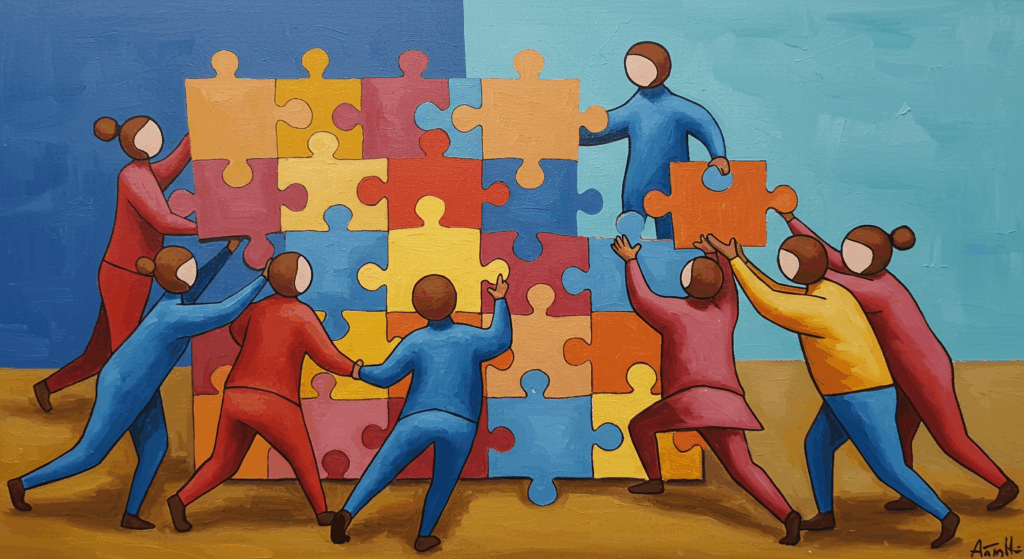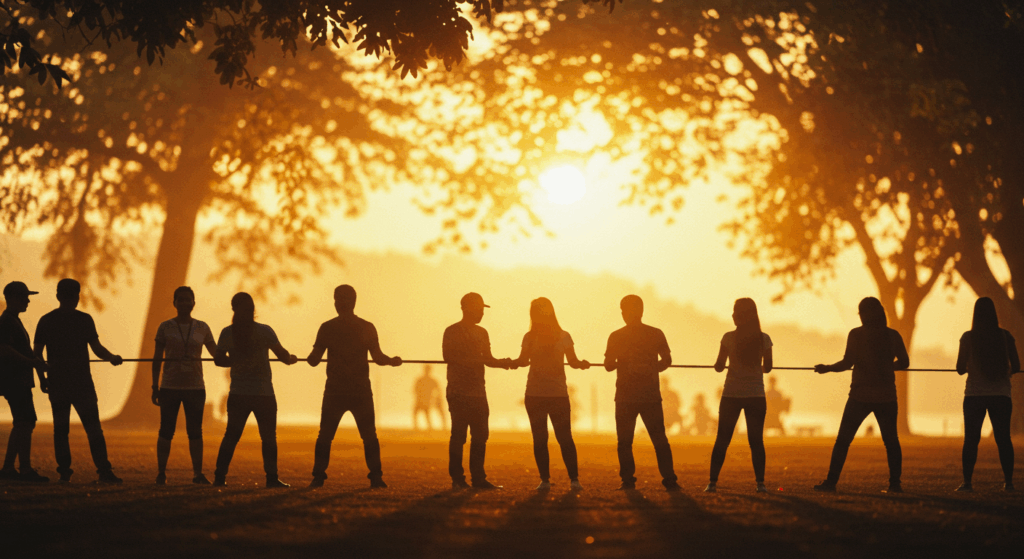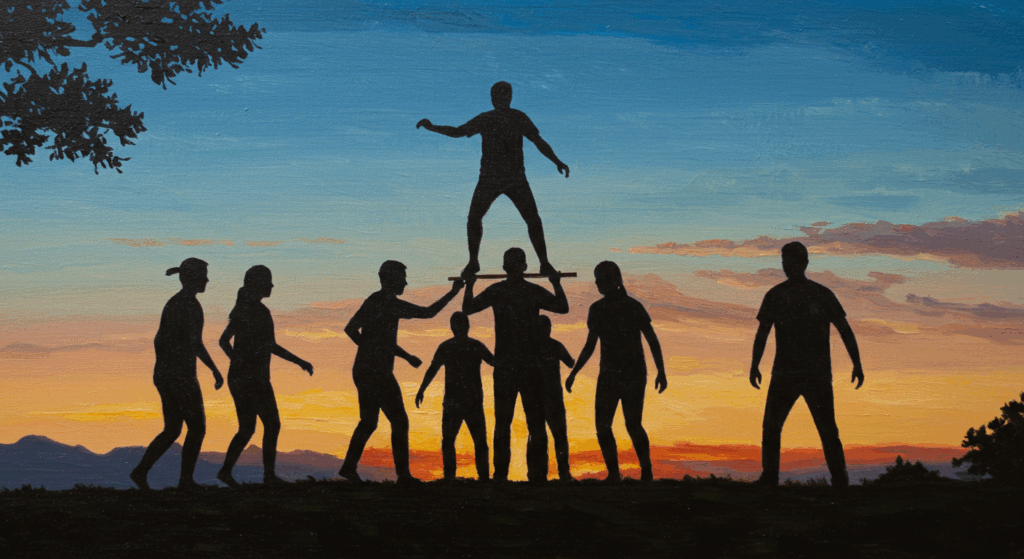If you’ve ever been trapped in a “mandatory fun” meeting where someone said “icebreaker” and your soul quietly left your body—same. Team building can feel cheesy if it’s done like a group project nobody asked for. But when it’s designed well (with real humans in mind), it can be fun-fun. Like, “we actually laughed and got work done faster after” fun. Today we’re going to talk about team building exercises that are genuinely enjoyable, including scavenger hunts, creative challenges, and fun games that skip the cringe and build real skills. I’ll share stuff you can run in 10 minutes, stuff you can turn into a Friday event, and ways to make it inclusive and not… weird. Deal?
Also, quick vibe-check: this is written like a friend talking to you over coffee—casual, a little messy, but real. I’ll toss in tips for remote/hybrid teams too because we’re all living on Zoom now. Let’s get into it.
Why Team Building Needs To Actually Be Fun (and not a forced group hug)
Here’s the truth: people don’t bond because you forced them into a room with sticky notes and a facilitator named Chad. People bond when they feel safe, a bit playful, and like their time is respected. Good team building:
- Creates psychological safety so people aren’t scared to look silly or be honest.
- Builds micro-trust through small wins—solving a clue, finishing a mini-build, telling a story.
- Connects real work skills: collaboration, creative thinking, clear communication, and calm under pressure.
- Feels like a break (not a chore) while still moving the team forward.
When you’re picking activities, ask: “Will my team genuinely enjoy this?” If the answer is “uhhh,” swap it. There’s always another option.
The Ground Rules So It Doesn’t Flop
A few guiding principles to keep things smooth:
- Time-box everything. People relax when they know how long it’ll take. Share an agenda up front—even if it’s loose.
- Choose low-risk, low-cringe activities. Avoid anything that forces vulnerability too fast (e.g., “share your deepest fear” at 9 a.m.). Save deep stuff for teams with strong trust already.
- Offer choice. Give alternatives for folks who don’t want to be on camera, can’t run around, or prefer quieter roles.
- Debrief lightly. A few reflective questions at the end make the fun connect to the work. Keep it short and respectful.
- Snacks. This is not optional, sorry. Brains fuel on coffee and a lil’ sugar.
Fast Warm-Ups (Fun Games You Can Run In 5–10 Minutes)
These are your “we’ve got a meeting starting in 10 but let’s not be robots” options. Quick, silly, no props.
One-Word Weather
How it works: Everyone describes their curent mood as a weather report: “Sunny with occasional emails,” “Foggy but warming,” “Hurricane but holding.”
Why it works: Fast emotional check-in that doesn’t get too personal.
Remote twist: Pop it in chat; vote on the funniest forecast.
Emoji Status
How it works: Share an emoji that explains your week and one sentence why.
Why it works: Tiny humor, tiny empathy.
Pro tip: Keep it PG (lol) and optional.
Silent Line-Up (Mini Collaboration)
How it works: Without talking, line up by birthday month, years at company, or shoe size.
Why it works: Nonverbal coordination builds awareness.
Remote twist: Use a collaborative whiteboard or drag your avatar on a shared slide.
Two Truths, One Stretch
How it works: Like Two Truths and a Lie, except the “lie” is a goal you’re stretching for.
Why it works: Gentle personal share + growth mindset.
Debrief nugget: What surprised you? What patterns did you notice?
Scavenger Hunts That People Actually Enjoy
“Scavenger hunts” can be peak chaos or peak joy. Done right, they blend movement, problem-solving, and laughter. Here are versions that don’t suck.
Photo Bingo Scavenger Hunt
Setup: Create a 3×3 bingo board with prompts like:
- “Something that represents our team values”
- “A totally extra coffee mug”
- “An object older than you”
- “A green thing with a story”
- “The number seven, somewhere”
How it works: Small groups have 20–30 minutes to snap photos that match squares. First team to get bingo (or most squares) wins.
Why it works: Engaging across personality types; lets storytellers and photographers shine.
Remote twist: Folks take pics at home and drop them into a shared board.
Debrief: Each group shares one fave photo + the mini-story behind it.
Keyword tie-in: This is one of those scavenger hunts that turns the ordinary into team lore.
Micro-Missions Hunt
Setup: Give teams a list of quick missions (2–3 minutes each):
- Record a 10-second clip explaining a household “life hack”
- Find an object that makes a funny sound and demo it
- Trade a small item with another team (virtually = swap emojis)
- Decode a short riddle to reveal your next mission
Why it works: Quick dopamine hits, small wins, lots of laughter.
Remote-friendly: Extremely. Distribute missions in a shared doc with timers.
Skill link: Prioritization, delegation, time management.
Knowledge Quest: The “We Actually Do Work” Hunt
Setup: Create clues that lead to documentation, dashboards, or product pages your team underuses.
How it works: Teams solve clues that reveal facts (e.g., “What metric moved most last quarter?”).
Why it works: Hidden training disguised as play (sneaky but effective).
Debrief: Ask, “What doc will you bookmark now?”
Pro tip: Keep scavenger hunts 30–45 minutes max. End on a high with a small prize. Stickers, gift cards, Starbucks runs… it’s the gesture.
Creative Challenges For Shy And Loud People Alike
Not everyone wants to be center stage, and that’s okay. These creative challenges give multiple roles—builders, writers, speakers, doodlers—so folks can play to strengths.
The Paper Bridge (With a Plot Twist)
Time: 20–30 minutes
Materials: Printer paper, tape, a small weight (like a stapler)
Goal: Build a bridge that holds the weight… with constraints.
Rules:
- Round 1: Free build (5 minutes)
- Round 2: Build again but now only one person can touch the materials; others can only ask questions (no commands)
- Round 3: Build again but the “engineer” can’t talk; others can only sketch
Why it works: Shows how communication styles matter.
Debrief: Which round felt harder? What did you learn about clarity and roles?
Meme Storyboards (The Crowd Favorite)
Time: 25–30 minutes
Materials: Slide template or whiteboard
Goal: Tell a short story about your team’s quarter using memes + 3 captions.
Why it works: Humor + narrative = retention.
Remote twist: Drop meme panels into a Miro board or Google Slides.
Debrief: What moments defined the quarter? What do we want Act II to be?
The Constraint Pitch
Time: 20–25 minutes
How it works: Give each group a random combo from three buckets:
- Audience: “Busy parents,” “Gen Z gamers,” “Plant lovers”
- Problem: “Too many notifications,” “Lonely commute,” “Messy fridge”
- Constraint: “Must use only three emojis,” “No words allowed,” “Budget = $10”
Teams create a one-minute pitch.
Why it works: Forces flexible, lateral thinking; super fun to watch.
Debrief: Which constraint unlocked creativity? Where did you get stuck?
LEGO (or Anything) Rapid Prototyping
Time: 20–30 minutes
Materials: LEGO, blocks, or random office supplies (paper clips, cups)
Prompt: “Build the perfect on-boarding experience as a physical model.”
Why it works: Translating abstract ideas into physical form reveals hidden assumptions.
Debrief: What features matter? What’s fluff?
Keyword nudge: These are creative challenges that translate directly to problem-solving at work, but still feel like play.
Fun Games That Build Real Skills (No Cringe, Promise)
Not all fun games are “fun” for everyone. These choices are cooperative, inclusive, and teachable.
Yes, And… But With Guardrails
Time: 10–15 minutes
How it works: Classic improv: Partner A starts a story; Partner B can only respond with “Yes, and…” to build the idea.
Why it works: Trains acceptance and additive thinking—useful in brainstorms.
Boundary: Avoid personal topics; keep it PG and silly.
Debrief: Where did momentum show up? Where did “no, but” sneak in?
The 5-Word Brief
Time: 10 minutes
How it works: Give any task a 5-word constraint (e.g., “Launch page for fall sale”). Teams must write a 5-word brief to align (“Fresh look. Clear CTA. Cozy.”).
Why it works: Forces prioritization and clarity.
Remote twist: Jam in a chat; vote with emojis.
Pipeline Relay
Time: 20 minutes
Materials: Straws, tape, ping-pong ball (or virtual = passing data through roles)
Goal: Build a pipeline that moves the ball from Point A to B without dropping.
Why it works: Systems thinking + coordination under time pressure.
Debrief: Where did errors happen? How did roles help or hurt?
“Pause-Play-Fast-Forward” Retrospective Game
Time: 20–25 minutes
How it works: In small groups, list what to Pause (stop), Play (keep), Fast-Forward (amplify).
Why it works: Turns retro into a game with action verbs.
Debrief: Pick 1 item from each to commit to this week.
A 90-Minute Plug-and-Play Session (Mixing Scavenger Hunts, Creative Challenges, and Fun Games)
If you want a one-and-done plan that doesn’t feel like a rigid outline but still flows, here’s a session that hits energy, collaboration, and reflection.
0:00–0:05 | Welcome + Vibe Check
Emoji Status or One-Word Weather. Light, fast, zero pressure.
0:05–0:30 | Photo Bingo Scavenger Hunt
Split into groups of 3–4. Snap pics, grab stories.
- Optional: Theme it around company values or quarterly goals.
0:30–0:50 | Meme Storyboards (Creative Challenge)
Keep groups or remix. Tell the story of your quarter with 3–4 meme panels.
- Tip: Give a template to speed it up.
0:50–1:10 | Yes, And… + 5-Word Brief (Fun Games)
Run two micro rounds.
- Round A (Yes, And…): Set a goofy topic (e.g., launching a new pizza-scented app).
- Round B (5-Word Brief): Apply to a real upcoming task.
1:10–1:25 | Debrief + Micro-Commitments
Ask:
- What energized you today?
- What surprised you about how we collaborate?
- One thing we’ll try this week (5 minutes to pick owners).
1:25–1:30 | Wrap + Thanks
Celebrate wins, snap a group screenshot, distribute a silly digital badge (yes, really).
This flow keeps momentum high, anchors fun to work, and closes with actions. Feels like a mini offsite without the bus ride.
Remote & Hybrid-Friendly Tweaks
A lot of teams are split across timezones and home desks. Here’s how to keep the joy when you’re not in the same room:
- Asynchronous scavenger hunts: Give a 24-hour window; people drop photos/stories into a shared board. Vote with reactions.
- Breakout rooms with clear roles: Facilitator, Timekeeper, Scribe, Vibes Captain (the “hype” person who keeps it playful).
- Camera-optional rules: Offer off-camera roles like scribe, curator, or soundboard DJ.
- Use shared artifacts: Slides, whiteboards, or docs that persist after the session so ideas don’t vanish into the Zoom void.
- Accessibility: Provide alt text for images; keep instructions written; avoid rapid-fire only verbal games.
Inclusivity Without Making It A Big Deal
You don’t have to announce “this is inclusive now.” Just design with people in mind:
- Physical access: If you’re doing in-office scavenger hunts, include seated tasks and routes that don’t require stairs.
- Social energy: Mix solo reflection + pair + group moments so introverts aren’t cooked.
- Cultural sensitivity: Avoid inside jokes or references that only some folks get. Keep prompts broad and welcoming.
- Neurodiversity: Provide structure (timers, written rules, examples). Let people opt out gracefully or choose quieter contributions.
Making It Stick: The 10-Minute Debrief
The fastest way to connect play to performance is a short debrief. Try one or two of these prompts:
- What helped our team move faster today?
- Where did assumptions trip us up?
- Which role did you naturally grab? Which role did you avoid?
- If we ran this again, what would we change first?
- What is one “tiny habit” we can bring to normal meetings this week?
Keep it 10 minutes. Stop while energy’s still high. People will actually want to do the next one, promise.
Budget-Friendly Options That Don’t Look Cheap
You don’t need a giant budget to make people smile:
- DIY props: Paper, tape, spoons, rubber bands become engineering toys.
- Digital-only creative challenges: Slides and memes cost $0.
- Prizes: Handwritten notes, “skip the next standup” coupons (lol), or a Slack shoutout.
- Local parks: Fresh air + space = better mood. Pack water and sunscreen; be a responsible adult.
What To Do If People Are Skeptical
Ahh, the eye-rolls. Totally normal. Here’s how to win them over:
- Start small. A 7-minute fun game beats a two-hour forced march.
- Tie to a real goal. “We’re doing this to practice quick alignment before the product launch.”
- Share the mic. Rotate who picks the next activity. Ownership = buy-in.
- Own the cringe. “We’re going to try this for 10 minutes. If it’s awful, I owe everyone cookies.” (It probably won’t be awful.)
Troubleshooting Common Pitfalls
- Too many instructions: Keep rules simple; then iterate once people start playing.
- Lopsided participation: Assign rotating roles. Invite quieter folks to be the “observer” who gives insights at the end.
- Time creep: Use visible timers; end early rather than late.
- Debrief becomes therapy: Stay focused on the work behaviors; refer deeper issues to proper channels.
A Mini Menu You Can Steal (By Goal)
- If you need energy fast: Emoji Status → Yes, And… → Photo Bingo
- If you want better brainstorming: 5-Word Brief → Constraint Pitch → Meme Storyboards
- If you want cross-team trust: Micro-Missions scavenger hunts → Paper Bridge → Pause-Play-Fast-Forward
- If you need async options: Async Photo Bingo → Knowledge Quest → Slack voting
- If you want creativity sparks: LEGO prototyping + creative challenges like Meme Storyboards
- If you want simple fun games: Silent Line-Up, Yes, And…, Pipeline Relay
A Few Real-World Tips From Running These A Bunch
- Announce with clarity and a wink. “We’re doing a 25-minute sprint to wake up our brains and make next week’s launch smoother. Yes there are memes.”
- Front-load the best activity. The first 15 minutes set the tone. Start with something easy and visual (Photo Bingo, Meme Storyboards).
- Celebrate tiny wins. Give out a goofy award: “Golden Stapler for engineering excellence.”
- Document outcomes. Snap photos of builds, save the meme deck, note 1–2 commitments. Add it to your team wiki so the fun has a footprint.
- Schedule cadence. Biweekly 15-minute fun games, quarterly 60–90 minute mix of scavenger hunts + creative challenges. Reliable > random.
Example Prompts You Can Copy-Paste
- Photo Bingo squares: “Something with the company color,” “A note you keep for motivation,” “A desk buddy (plant, pet, plushie),” “A confusing cable,” “A snack that slaps.”
- Constraint Pitch seeds: Audience: “Night shift workers” / Problem: “Too many tabs” / Constraint: “Explain using only icons.”
- Yes, And starter: “We’re opening a pop-up shop that sells digital high-fives.” Go.
Measuring Impact Without Killing the Vibe
You can prove this isn’t just silliness by tracking lightweight signals:
- Pulse survey (3 Qs): “I feel more comfortable speaking up,” “I know my teammates better,” “Today’s activities connect to our work.”
- Behavioral micro-metrics: Next week’s standups are shorter; brainstorms produce more ideas; handoffs have fewer “wait, what?” moments.
- Artifact count: # of ideas captured, docs bookmarked, memes saved (yes, really).
- Qual quotes: Grab one or two comments and toss them into your recap.
Quick Start Kits (So You Can Run One Tomorrow)
10-Minute Starter
- Emoji Status (2 min)
- 5-Word Brief for today’s top task (5 min)
- Debrief: “What’s our one focus?” (3 min)
30-Minute Boost
- Photo Bingo (15 min)
- Yes, And… (10 min)
- Micro-debrief (5 min)
60-Minute Maker
- Micro-Missions scavenger hunts (20 min)
- Constraint Pitch (20 min)
- Pause-Play-Fast-Forward retro game (15 min)
- Close (5 min)
Tiny Things That Make A Big Difference
- Play music at low volume while people build (Spotify lo-fi, anyone?).
- Use timers folks can see.
- Give clear roles every time.
- Offer opt-outs without pressure.
- Keep humor kind, not punch-down.
- Snacks. (Yes, repeating myself. Snacks.)
What If You’re Fully Remote and Different Timezones?
Do short bursts. Keep it async-friendly. A sample week for global teams:
- Monday: Post the Photo Bingo board; people submit 1–2 pics whenever.
- Wednesday: 10-minute “Yes, And…” round in regional standups.
- Friday: Share the Meme Storyboard compilation + 5-minute comment thread.
- Rolling retro: Pause-Play-Fast-Forward lives in a shared doc; folks add 1 item anytime.
This rhythm respects calendars and still gives you scavenger hunts, creative challenges, and fun games sprinkled across the week.
Okay But… Will This Actually Help Our Work?
Short answer: yes—if you connect it. The activities themselves create micro-experiences where your team practices listening, building on ideas, handling constraints, and dividing roles under time pressure. That’s… basically work, right? The small debrief and the carryover (“Let’s try 5-word briefs in our brainstorming”) make the benefits stick.
Also, not to be drsamatic, but laughing with your coworkers once a week can reset a whole vibe. People assume the best of each other. That saves soooo many Slack threads.
Make Your Own Mix (You Don’t Need Permission)
Feel free to remix everything here. Swap Meme Storyboards for a 10-slide “PechaKucha” challenge. Replace Photo Bingo with “Household Olympics” (who can stack the most books in 30 seconds—safely!). Turn Pipeline Relay into a Notion database relay. The only real rules are: keep it kind, keep it short, and keep it purposeful.
Final Rapid-Fire Ideas (Because You Might Need More)
- Desk Safari: Pair up; combine your faces with animal photos for cursed creations. Fast laughs.
- Name That Tune (Work Edition): 5-second song intros while someone summarizes a project in one sentence.
- Brand Swap: Reimagine your product as if created by a completely different brand (tone, fonts, features).
- Guided Doodle: One person describes a shape-based scene; others draw blindly. Reveal and giggle.
- Lightning Talk Roulette: 3 slides, 2 minutes, random topic. Keep it safe and silly.
Bring It Home
Good team building is basically structured play—with intention. When you center psychological safety, keep it brief, and connect it to the work, the “fun” isn’t fluff. It’s fuel. Whether you’re running scavenger hunts that reveal hidden skills, tossing out creative challenges that spark wild ideas, or choosing fun games that teach collaboration without the lecture, you’ll see the ripple effects in meetings, handoffs, and deliverables.
If you’ve read this far, you’re already the kind of person who cares about your team’s vibe (and results). So pick one tiny thing and try it this week—seriously, even a 7-minute warm-up. Then notice what shifts. Ngl, it might feel a little awkward for, like, ten seconds. And then it gets easier. fun. And more “us.”
You got this. Go start small, keep it kind, and make something a little delightful happen for your team today.









